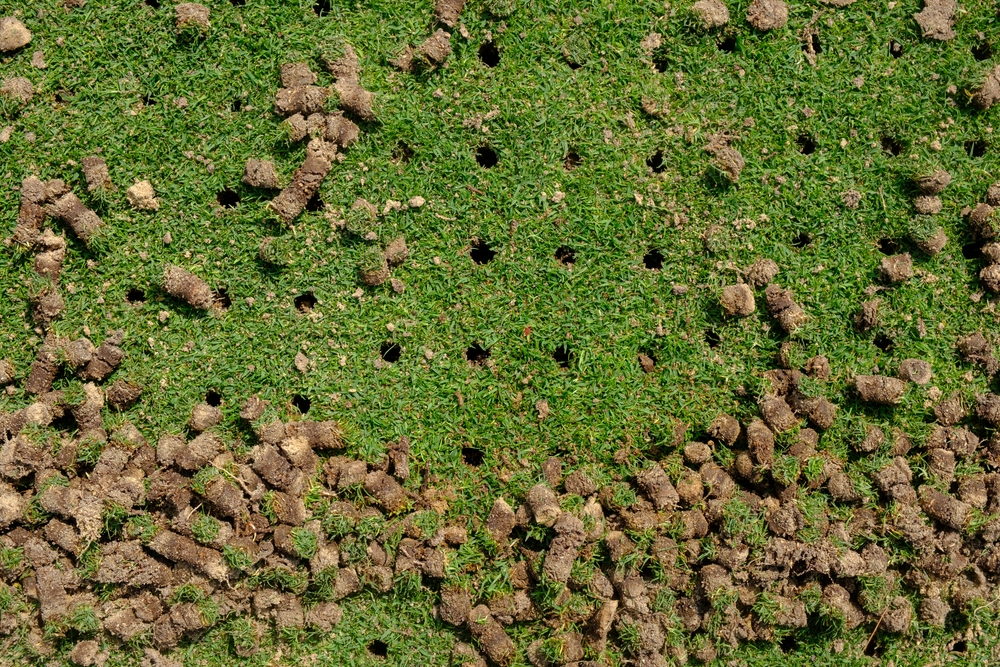
If you’re dreaming of a lush, green lawn, knowing when and how to aerate your lawn is key to achieving it. Unfortunately, aeration is one of those essential lawn care tasks that gets mishandled or completely overlooked. In order to maximize its benefits, you must time it right. And the first step in doing so is understanding that the best season for aeration differs for cool-season and warm-season grasses.
When You Should Aerate Your Lawn Based on Grass Type
The timing of aeration can make a significant difference in your lawn’s health and appearance. Generally, the season for aeration depends on the type of grass you have: cool-season grasses, like fescues and ryegrass, and warm-season grasses, like Bermuda and Zoysia, have different growth patterns, which should guide your aeration schedule.
Cool-Season Grasses
Cool-season grasses thrive in the early spring and fall when temperatures are mild. For these grass types, fall is the ideal time for aeration, as the soil is still warm enough to encourage quick recovery, while the cooler air temperatures reduce stress on the grass. Aerating in the fall also allows the grass to breathe, grow, and prepare for the cooler winter months. Additionally, fall aeration provides an opportunity for overseeding, which can help fill in bare spots and encourage a fuller, more resilient lawn come spring.
- Best Time: Early to mid-fall, around September to October, depending on your region.
- Why Fall?: Fall provides optimal growing conditions for cool-season grasses, enabling them to establish a stronger root system before winter.
Warm-Season Grasses
For warm-season grasses, late spring to early summer is the best time to aerate. These grasses thrive in warmer temperatures, so aerating when the soil is warm and the grass is actively growing allows it to recover quickly and take advantage of the growing season. This timing also makes lawns more drought-tolerant, as the process of aeration provides the grass roots with the air, nutrients, and water they need.
- Best Time: Late spring to early summer, from May to early June, depending on local temperatures.
- Why Late Spring?: This timing aligns with the active growth phase of warm-season grasses, helping them establish a strong root system and develop resilience to summer heat.
The Importance of Aerating Your Lawn
Now that you know when to aerate, let’s talk about why core aeration is such a powerful tool for a healthy, beautiful lawn.
Improves Soil Health and Relieves Compaction
Aeration addresses one of the most common issues in lawns: soil compaction. Over time, foot traffic, lawn equipment, and natural soil settling can lead to compacted soil, which restricts the movement of water, air, and nutrients. By removing small plugs of soil, you relieve soil compaction and provide roots with the resources they need to grow deeper and stronger. And healthy roots translate into better resistance against drought, pests, and diseases.
Enhances Nutrient Absorption
If the nitrogen, phosphorus, and potassium found in your fertilizer can’t penetrate deep beneath the soil, your lawn care efforts will be for naught. Fertilization and aeration go hand-in-hand, so don’t forget to aerate first. After aeration, nutrients from fertilizers and organic matter can reach the grass roots more effectively. This allows the grass to grow more vibrantly — all while reducing the amount of fertilizers you have to use.
Increases Water Infiltration and Retention
Compacted soil often causes water to run off the surface, causing you to run your sprinkler system much longer than necessary to only potentially see your desired results. Consider investing in lawn aeration to allow water to soak deep into the soil, where it can be absorbed by the roots. This process is highly beneficial during dry periods, as the lawn can hold onto more water.
Reduces Thatch Buildup
Thatch, a layer of dead grass, roots, and organic material, can accumulate on your lawn’s surface over time. While a small amount of thatch is natural, too much can prevent water, air, and nutrients from reaching the soil. Aeration helps break down excessive thatch by encouraging the natural decomposition of organic matter.
Contact Lawn Specialties for Expert Lawn Aeration
Aeration is a valuable step in achieving a healthy lawn, but timing and technique are everything. Whether you have cool-season or warm-season grass, aerating at the right time will help your lawn flourish.
If you’re looking to give your lawn the boost it needs, our team at Lawn Specialties is here to help. We offer professional aeration services, customized for your lawn’s specific needs, and can even provide further guidance on caring for your landscape — including how often to aerate and why you should fertilize your lawn. Contact us today, and let’s get started on transforming your lawn.

